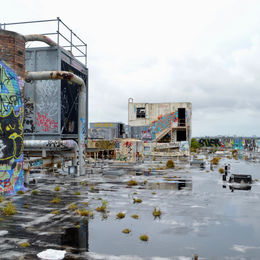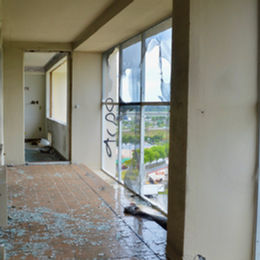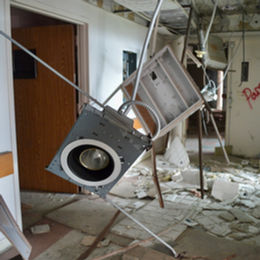
The Urban Coroner
Photography By Sugarbomb
PARKWAY WEST REGIONAL MEDICAL CENTER
For decades, the graffiti-covered visage of Parkway West Regional Medical Center – or what's left of it – stood prominently overlooking the Golden Glades Interchange.

Parkway West Regional Medical Center | Photo © 2014 Sugarbomb
It was one of those places I found simply by watching the 10pm news. They were reporting on a story about the abandoned Parkway West Regional Medical Center that had languished in ever-increasing disrepair for decades right near the Palmetto Expressway at the Golden Glades Interchange in Miami Gardens. I'm pretty sure it wasn't their intention to inform me about a new abandoned place to explore, but that was definitely the result.
Construction began on Parkway West Regional Medical Center in 1972 in the area that would become Miami Gardens. This was in the days before Hard Rock Stadium was a glimmer in the eyes of city officials and much of the area that is now Miami Gardens was smaller unincorporated communities and farmland. The hospital was completed in 1974 and was a state-of-the-art medical facility at the time, towering over the surrounding area. The 11-story hospital had 127 rooms and the ability to accommodate over 300 patients.
Taking advantage of Miami's warm climate and substantial sunshine, the patient rooms had large windows and some of the top floors even had screened-in balconies.

A hospital bed still inside Parkway | Photo © 2014 Sugarbomb
While technically 11 stories tall, the hospital was actually designed to have 10 floors and a basement. The basement was limited to hospital staff and not meant for patients...at least not living patients. The morgue was located in the basement, which was actually at ground level, as basements in South Florida aren't feasible due to the high water table and proximity to the ocean. With its own separate door at ground level and located away from public areas, this made it possible for bodies to be transported from the hospital's morgue without wheeling them through the lobby or something equally uncomfortable. Offices, maintenance areas, boilers, storage, and other operational needs were located in the basement as well.
The emergency room and the lobby were located on the first floor. There was also a small cafeteria, reception area, gift shop, meeting rooms, and more administrative offices located on the first floor, including the office of the medical director.

The X-Ray on the second floor | Photo © 2014 Sugarbomb
The second floor housed x-rays, electroencephalogram machine (EEG) and dictating room, labs, and other diagnostic testing equipment. Some patient records and x-rays were also kept on the second floor – and like pretty much every other abandoned hospital I've found, many were left behind when the hospital shut its doors.
The operating rooms and recovery rooms were located on the third floor, with many areas still marked by signs indicating that one must have proper O. R. attire to enter.
The CCU - or critical care unit - was located on the fourth floor and was meant for critically ill patients that required round-the-clock supervision and care, similar to an ICU or intensive care unit. The sign posted on the double doors leading into the CCU indicated strict limitations on visitation for patients in that specialized unit, with visiting hours from 2pm to 8pm, only two visitors allowed at a time, and visits limited to 5 minutes every hour.
Parkway had a psych ward on the seventh floor with a designated receiving unit for patients admitted for psychiatric care under the Baker Act. The Florida Mental Health Act of 1972, commonly referred to as the Baker Act, created legal procedures to allow for the involuntary examination or commitment of patients that are reasonably believed to be a danger to themselves or others or are unable to care for themselves.
On December 3, 1998, a psychiatric patient that had been admitted to Parkway murdered his psychiatrist Dr. Christina Gabriele Smith. Knollys Sterling had previously been found mentally incompetent by a Miami-Dade judge and remanded to the psychiatric ward at Parkway. There was an argument between Dr. Smith and Sterling, at which time Sterling went to his room and retrieved the .380 caliber gun, shooting Dr. Smith twice in the chest.
After the shooting, Sterling attempted to flee, firing at anyone that attempted to subdue him. James Reed, who had been leading a Narcotics Anonymous meeting down the hall, was grazed in the leg. Another man from the meeting managed to get ahold of Sterling and restrain him until North Miami Beach police officer Christopher Starnes came up the elevator and handcuffed the gunman. Dr. Christina Smith was airlifted to another hospital but succumbed to her injuries.

Patient rooms and the nurses station on one of the upper floors | Photo © 2012 Sugarbomb
An investigation after the incident aimed to discover how a Baker Act patient was able to smuggle a weapon into the hospital. It was found that “lapses in safety measures” occurred, in which Sterling was permitted to return to his home to fetch some of his belongings, which included the loaded gun. The gunman hid the weapon inside a typewriter and returned to the hospital.
After the incident and a subsequent investigation, the Joint Commission on the Accreditation of Healthcare Organizations lowered Parkway's rating from full to conditional accreditation. While the nationwide commission's approval rating is voluntary, it is highly regarded as a sign of quality. This loss of accreditation would cost the hospital millions of dollars annually, as it could cut off Parkway's capabilities to serve Medicare and Medicaid clients.
The murder of Dr. Christina Smith was not the first issue Parkway had experienced with its psych ward patients. A month before the murder, a mental patient had committed suicide by jumping out of a hospital window at Parkway, raising further concerns regarding security and the safeguarding of patients and staff.

The lobby entrance on the first floor with the gift shop on the left | Photo © 2012 Sugarbomb
Parkway West Regional Medical Center closed its doors in 2002 and cycled through a series of owners with grand plans for the property over the next few decades. In 2004, the property was bought by Jacob Sopher, President of Ace Parking Management, for $4.2 million. A plan put forward in 2009 by a group of local businessmen would have seen Parkway renovated into an assisted living facility. The $22 million endeavor was to be named Diamond Point and would have 150 rooms and 50-100 employees, but it never materialized.
As plans and owners came and went, the old hospital continued to decay, racking up liens and code violations and standing as a constant source of ire for city officials and residents. In November 2010, the mayor lamented over how bad the condition of the building had gotten, and in April 2011 local news stations featured segments about the deteriorating building standing tall next to the Golden Glades Interchange and greeting drivers with broken windows and often offensive graffiti. The new owner, BSD of Miami Gardens, was working on plans to gut the building and build commercial and residential units. These plans for Parkway, like many before, fell through and in January 2015 the property was facing foreclosure.

A minefield of debris in the split hallways on the tenth floor at Parkway | Photo © 2014 Sugarbomb
Since it's abandonment, Parkway has attracted all manner of taggers, scrappers, ghost hunters, and of course urban explorers. Less than a decade after being closed, the old hospital was essentially being torn down from the inside out. Large pieces of metal hung precariously throughout the dark halls and ceiling tiles littered the floor. On many floors the doors to the elevator shafts had been pushed open or completely torn away, opening into a free fall of however many stories up one happened to be. Graffiti covered the walls both inside and outside the hospital. Scrappers had torn all they could from the walls, ceilings, and anything they could get their hands on.
On the floors where patients were housed, the large windows had been broken by both vagrants and the elements over the years and gusts of wind would often cause doors to fly open and slam closed out of nowhere. For once, unlike all the horror movies we've all seen, it WAS just the wind. Walking through the halls at Parkway was like navigating an obstacle course of dangling metal and fallen debris that could easily land you in a non-abandoned hospital needing a tetanus shot and stitches.
Several years later in 2018 not much had changed with Parkway. The owners of the property had been in foreclosure for years, and then filed for bankruptcy. At that point the owner's plan to redevelop the property into a hotel had been on hold indefinitely. In the meantime, it was all the owners and the city could do to keep up with removing the most offensive of the graffiti.
"Over the years we have had racial slurs removed from the walls. We've had swastikas removed from the wall. You know all manner of derogatory statements and graphics removed from the wall. So this will just be another one," Miami Gardens Mayor Oliver Gilbert said to a local news outlet in June 2018 in response to the graffiti decorating the outside of Parkway.

The entrance to the emergency room on the first floor looking straight out of Silent Hill | Photo © 2012 Sugarbomb
Police and city officials made efforts to keep people out of the abandoned hospital, but often these efforts were in vain. To be fair, there's more important crimes to be stopped on your average day than a couple of people going into an old building looking for a thrill. Miami police either care a whole lot about abandoned places and will arrest you on sight, or not at all and will sit there and watch you walk in without a care in the world, and they will vacillate between these two options every few years without warning it seems. Who knows which one they're on today? Not you. Good luck.
In a way, one could argue – albeit probably ineffectively – that we had a right to be there. Two of my friends, both of whom have explored this place with me several times, were actually born in this hospital. In fact, having a hospital so close to where many of us grew up I've come across many people in my daily life that had been to that hospital when it was still open and operating. The receptionist at my dentist office told me about the time she had taken her son there to get his first set of stitches after a minor accident in the 1980s.

One of the dark hallways on the second floor with patient rooms. As you can see from outside photos of the hospital, it was only the fourth floor and above that had the large windows. These lower floors were pitch black. | Photo © 2014 Sugarbomb
Not all who wandered the perilous halls of Parkway had such benign intentions as hunting for spirits, taking some pictures, or spray painting a poorly rendered dick on a wall for a chuckle. On April 1, 2019, police got a tip that a murder suspect was hiding out in the abandoned hospital. Police responded to a call about a possible assault at an apartment complex in Miami Gardens, at which time they found the mutilated bodies of 49-year-old Lorrice Harris on the back porch and 10-year-old Shayla Chambers in a bedroom. 29-year-old Shanalee Chambers was also injured in the attack and was hospitalized in critical condition, thankfully surviving the attack, and going on to make a full recovery. Noel Chambers was responsible for the heinous crime, attacking Lorrice Harris and their daughters with a machete after Harris told him that she was leaving him. Heavily armed police officers surrounded and searched the abandoned hospital as part of a days-long manhunt for Chambers, who was eventually taken into custody several days after the attack when firefighters spotted him near the fire station.
A machete-wielding psychopath hiding in a dark corner is not the only peril you face when exploring the crumbling remains of Parkway West Regional Medical Center. In addition to weaving your way through the detritus dangling above and strewn below you, the stairways that take you from floor to floor are pitch black. The railings have long since been removed, likely taken for scrap, leaving a convenient open space to tumble down into if you're not careful. The old elevator shafts on either side of the building are equally treacherous. With no doors blocking most of them, what you'll find instead is a wide-open chasm where the lift used to operate. 21-year-old Adrian Valenzuela and his friends found this out in the most unfortunate way possible.
In October 2020, Valenzuela and three of his friends were exploring the former hospital. While on one of the upper floors, Valenzuela walked away from the group to make a phone call and moments later they heard a loud bang. It was discovered that he had accidentally stepped into the dark stairwell and fallen to his death. His phone was found on one floor, his flip flops on another, and his body finally landing on another.

One of the stairwells...one wrong step could send you tumbling down hundreds of feet | Photo © 2011 Sugarbomb
So...is it haunted? Well, yeah. All hospitals are haunted, even the ones that aren't abandoned. Most hospitals are just so busy with hustle and bustle that you don't really notice the paranormal comings and goings, though in many cases people that work in the hospitals will tell you that there's definitely activity there. They see it because they're the ones in those quiet hallways where little action takes place. It's the same in abandoned hospitals. It's not that ghosts ONLY come out in the dark or in abandoned places, just that it's far easier to notice that sort of thing when you don't have that much living action around you. Things are just as haunted in the light as they are in the dark. If you've ever been to a hospital in your life, you've already been to a haunted hospital.
Parkway is no different. Visitors have risked injury and arrest to catch a glimpse of the paranormal within the old hospital, and it's said that many have gotten what they've asked for. There are plenty of stories of murderers dumping dead bodies in the basement and crazed drug addicts overdosing in the old building, though none of these are substantiated. There's enough that's already been covered here, and plenty that I'm sure we'll never know about, that is more than enough to understand why this place would be haunted.
The basement, the emergency room on the first floor, the operating rooms, and the seventh-floor psych ward are reported to be the most haunted parts of the building. However, visitors to Parkway have claimed to see shadows and hear strange or unexplained noises throughout the entire building. Many people have also reported the unnerving sensation of being watched while exploring the old hospital.

The morgue in the basement at Parkway | Photo © 2013 Sugarbomb
The basement is often said to be one of the most haunted parts of the building. The morgue is in the basement, the two-compartment body cooler still mostly intact in the small, yellow-tiled room. Visitors claim to feel an overwhelming sense of dread and a feeling of impending doom when entering the basement. People will often report a horrible stench in the basement and claim it's the stench of rotting human flesh. Putting aside the fact that most people don't really know what rotting human flesh smells like - other than "bad" - the pungent odor could also be due to the fact that the basement, located at ground level, regularly floods. A mostly enclosed basement floor with decades of flooding and accumulated muck along with the outrageous Florida heat and humidity would definitely account for a pretty damn bad stench. It also accounts for a perfect breeding ground for billions of ravenous mosquitoes. Ask me how I know. Also, ask me how I learned that wearing tank tops and shorts while urban exploring in June is a really stupid idea. But I digress...
A woman in a hospital gown is another common specter encountered in the halls of Parkway. While the hospital was still in operation, it is said that the woman was having complications during childbirth and rushed into emergency surgery. While her baby was successfully delivered, the woman did not survive. People who have explored the now-abandoned hospital claim to have seen this woman walking the halls looking for her child, though she seems unaware of her surroundings and does not acknowledge the living who encounter her. The operating rooms were located on the third floor, and this is frequently where she will be seen.
The psych ward on the seventh floor is considered another "hot spot" of paranormal activity. While Dr. Christina Smith did not succumb to her injuries at Parkway, claims are that the incident, or just the general energy that comes along with a psych ward, left a lasting mark on the building. People who have explored the building report seeing shadow people on the seventh floor, as well as hearing the echoes of gunfire and blood-curdling screams.
Whether these experiences with the paranormal are real or the product of an overactive imagination reacting to a "creepy" abandoned hospital – or a combination of the two – that’s up for debate. Personally, I have never come across any of these spirits in the times I've explored Parkway. But, as I've probably stated in previous writings, I'm about as sensitive to the paranormal as a cucumber. A spirit could be twerking two feet in front of my face, and I likely wouldn’t notice a thing.

The hallway leading to the operating rooms on the third floor | Photo © 2014 Sugarbomb
After two decades of failed plans, code violations and liens, indecent graffiti, and unfortunate accidents, the property was purchased for $11 million by Miami Beach-based developer the Haimov Group. In April 2022, it was announced that development strategies for the property had been finalized and the building would be demolished. In a press conference discussing the demolition of the abandoned Parkway hospital, the Miami Gardens mayor described it as having been a blight to the community for a long time. Located near the Hard Rock Stadium, the plan is to build a convention center with a hotel and event space on the three-and-a-half-acre prime parcel of land. The nearly $200 million project will consist of a two to three story convention center, a 20-story hotel with about 150 rooms, and a wedding venue, according to the developer.
A ribbon cutting ceremony was held on February 28, 2023 as demolition began on the old Parkway West Regional Medical Center. It was estimated that the entire process, which would utilize a "chipping" method of demolition rather than imploding the structure, would take about four months to complete. Miami Gardens Mayor Rodney Harris told the Miami Herald that with this project he hopes to “build something that’s going to be a lasting beacon of hope, a beacon of innovation, and something that people in the community can really be proud of.”
Aerial view of the former Parkway hospital in the process of being demolished, taken February 28, 2023 | Source: The Miami Herald

























